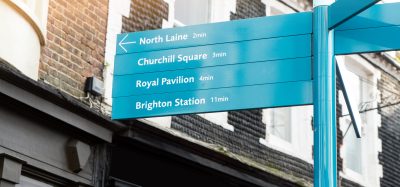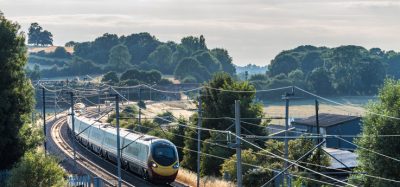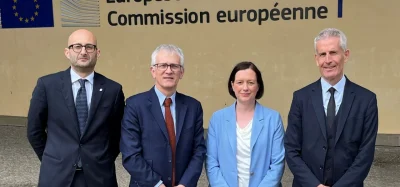On the home straight
Posted: 31 May 2006 | | No comments yet
The UK’s first high speed railway,The Channel Tunnel Rail Link, is entering the final phase of construction. Dave Pointon, Managing Director of Union Railways, reviews progress and looks ahead to finishing the job in 2007.
The UK’s first high speed railway,The Channel Tunnel Rail Link, is entering the final phase of construction. Dave Pointon, Managing Director of Union Railways, reviews progress and looks ahead to finishing the job in 2007.
The UK’s first high speed railway,The Channel Tunnel Rail Link, is entering the final phase of construction. Dave Pointon, Managing Director of Union Railways, reviews progress and looks ahead to finishing the job in 2007.
Building a new railway has three distinct phases:
- Civil engineering to produce the alignment
- Railway engineering to install the ‘hard’ (track and overhead line) and soft (signalling, control and communications) systems
- Testing and commissioning
When stations and depots are involved, there are effectively two more intermediate stages to be added to the programme – structural build and fit-out. CTRL Section 2 is making good progress with the railway engineering phase and over the next year, is concentrating on fit-out and preparations for testing and commissioning.
Section 2 is significantly more complex than Section 1 because it incorporates 20 route kms of tunnels, two new intermediate stations, a new train maintenance depot and the enormous task of turning St Pancras station, a 140 year old Grade 1-listed Victorian terminus, into a major international gateway and interchange. The 109km Channel Tunnel Rail Link (CTRL) links the Channel Tunnel with a new international London terminal at St Pancras. It will reduce international journey times from London to Paris by Eurostar to 2h 15m and just under two hours to Brussels – a 35 minute improvement over pre-CTRL timings.
Civil engineering on the main alignment of Section 2 started in mid-2001, and was essentially finished by the end of 2004. Major risks to the programme and budget included the extensive tunnelling – 2.5km beneath the Thames in wet, flint-infested ground, and 17.5km beneath east London – which our eight tunnel boring machines successfully worked over an 18 month period between Autumn 2002 and Spring 2004. Other notable elements of the civil engineering phase were the ‘push launch’ construction of a 1.3km viaduct across the M25 London Orbital Thames Crossing at Thurrock without disrupting motorway traffic, the sinking of 6,000 piles to support the track over the Inner Thames marshes between Purfleet and Dagenham and the excavation of a 1km-long, 50m-wide and 23m-deep open ‘box’midway along the London tunnels at Stratford for the new International station.
Civil engineering works along the route were divided geographically into eight contracts, but for the railwayequipment phase the division is functional, with the contracts known collectively as ‘Systemwide’. The three principal Systemwide contracts are:
- Track and overhead lines
- Signalling and control
- Non-traction electrical supply & M&E equipment
Smaller contracts cover data transmission, telephones, radio and CCTV. The track and overhead contractor also has the responsibility for co-ordinating testing and commissioning of all systems. High voltage power for traction and as a feeder for low voltage requirements is supplied by EDF Energy. Section 1 of the new line through Kent has been operational since September 2003, but the journey through the London suburbs to the existing terminal at Waterloo is still on the classic, capacity-constrained network, shared with domestic services and mostly limited to 100km/h.
On the surface sections, track is conventionally deep ballasted using duo-bloc concrete sleepers and UIC60 section rails. There is one plain-line 160km/h crossover pair on the surface section, at Wennington, and more crossovers at Ebbsfleet station in north Kent.
There are also connecting spurs to the adjacent Network Rail lines at Ebbsfleet and at Dagenham, close to the eastern end of the London tunnel. The Ebbsfleet link will be used by high speed domestic services running between St Pancras, and Gravesend, the Medway towns and north Kent. The Dagenham connections are intended for use by international freight trains bound to or from the existing cross-London routes and beyond.
In the tunnels, concrete slab track has been installed on a pre-canted sub-slab laid in the tunnel invert by a paving machine. The tunnel track incorporates two-stage noise and vibration mitigation in order to meet our groundborne noise design commitment (not more than 40Db LAMax(S) from the passage of a single train). The duo-bloc sleepers are set in rubber boots which form the contact medium between the sleeper and the sub-slab and secondary concrete layer, and a secondary pad is inserted in each chair beneath the rail.
Completion of the 39km Section 2 into central London will give Eurostar a dedicated route to the Channel Tunnel and through to the LGV network in France, further boosting service reliability which saw a significant upturn when Section 1 opened. From late 2009, Eurostar will be joined on the CTRL by a new generation of domestic high speed trains between Kent and London which will dramatically reduce journey times in a region which has historically had slow and unreliable rail services.
The contractor ACT (Alstom-Carillion-Travaux Sud-Ouest) has physically completed the track and overhead line installation from the junction with Section 1 through to the western end of the London tunnels. Electrification of the 25kv overhead line over this part of the line is planned for early 2007 once the supply and control systems have been completed and commissioned.
On most of Section 2, train control is by the proven TVM 430 in-cab speed signalling system used on the LGV network in France and with which Eurostar trains are already equipped. In the immediate St Pancras area where running speeds are relatively low, conventional lineside signalling is used, supported by a speed monitoring and intervention system known as KVB (Contrôle de Vitesse par Balises à télégramme), which is also the existing equipment on Eurostar. Signalling is controlled from the Route Control Centre (RCC) at Ashford (which already controls Section 1) via five lineside signalling rooms. The contractor CSEE is progressing well with preliminary testing of the signalling systems and also EMMIS (Electrical & Mechanical Management Information System), the means by which the RCC monitors and controls the railway operational systems.
The twin bore, single track London and Thames tunnels are bi-directionally signalled for full speed running (230km/h on Section 2), and there are crossovers at the western portal of the London tunnels (80km/h) and in the Stratford ‘box’ (60/80/100km/h, depending on route). The two bores of the London tunnels are connected by sealable cross passages at intervals of around 500m. Five of the cross passages are linked to ventilation shafts which contain powerful fans able to operate in either extraction or input mode. Centralised control of ventilation across all shafts and of jet fans within the tunnels enables directional control of the air flow in the tunnels in the event of an incident. The shafts also provide access to the tunnels for technical staff or the emergency services, but are not intended as a means of escape during an emergency. If it becomes necessary to evacuate a train in a tunnel, passengers would be guided along a walkway to the nearest cross passages and taken to safety in a train in the parallel tunnel.
The LCR has the Public Private Partnership contract with the UK’s Government to build and operate the CTRL. Funded partly by the UK taxpayer and partly by long term corporate bonds issued by LCR, the line is leased to LCR, which will earn income from access charges paid by Eurostar and the domestic operator, and potentially also by passenger and freight Open Access operators. LCR also owns Eurostar UK, the UK element of the Anglo/French/Belgian Eurostar operation, and has property development interests linked to the route of the CTRL.
The mechanical and electrical requirements of Section 2 are much more significant than on Section 1 and the scope of the main M&E contractor Emcor is therefore very broad. It includes the design and installation of low voltage power distribution, pumping and lighting within the tunnels and headhouses, as well as the installation of the signalling and communications systems. The work involves Emcor in complex interfaces with power supplier EDF Energy and each Systemwide contractor for whom Emcor is systems installer and low voltage power supplier.
Another aspect of Section 2 which did not feature on Section 1 is the requirement for the full range of building services to deliver the stations and the new Eurostar maintenance depot at Temple Mills near Stratford. The two intermediate stations, at Stratford in east London and at Ebbsfleet, adjacent to the M25 and A2 in north Kent, will be physically complete in the spring and summer of 2006 respectively, and the depot will follow towards the end of the year. Commissioning of the station operational systems (passenger information, train despatch etc) and the operational interfaces between the railway and the depot, which are driven by the Systemwide works, will follow as part of the overall testing & commissioning phase in 2007.
It is at the terminus at St Pancras that the biggest tasks remain and where the project’s critical path lies. The station must be lengthened to provide platforms capable of taking the 20-vehicle, 393m-long Eurostars, and the 140 year old structure must be renovated and adapted to incorporate the modern facilities expected by today’s travellers that were unknown to the Victorians. Not only is St Pancras a Grade 1- listed building, but it is also the London home of domestic train operator Midland Mainline (MML). In order to keep MML operational the CTRL works have been phased and by the time the station is finished, MML’s operations will have moved twice within the overall complex.
In spring 2004, MML moved from the old part of the station, known as the Barlow shed after its designer William Barlow, Chief Engineer of the Midland Railway, into a temporary home on the eastern half of the new extension, which had been under construction since early 2002. This allowed the CTRL project to demolish the brick viaducts which carried the MML tracks into the Barlow shed, and which stood in the way both of the excavation of a sub-surface ‘box’ for a new station on the Thameslink lines which run beneath St Pancras, and the construction of the western half of the station extension.
MML’s move also gave CTRL’s St Pancras contractor, CORBER (Costain-Laing O’Rourke-Bachy- Emcor Rail) access into the Barlow shed to begin the refurbishment task at three levels – roof, train deck and undercroft beneath the train deck. The Thameslink ‘box’ was completed on schedule in May 2005 after a 35-week closure of the Thameslink route, and the western extension above it is now approaching structural completion.
Union Railways is a subsidiary of LCR and is the Client for the project. Rail Link Engineering (RLE), a consortium of four of the LCR shareholders (Arup, Bechtel, Halcrow and Systra) is the project manager, responsible for much of the design, and also procurement and construction management. Partnership contracts built around agreed target prices with pain/gain shares incentivise RLE (for the project as a whole) and individual construction contractors against financial and programme targets.
The next CTRL milestone is to complete what will be platforms 1 to 4 of the new station on the western extension, and move MML into them in summer 2006. This will enable the interim arrangements put in place for MML on the eastern extension in 2004 to be modified to the final configuration. Eventually, the three eastern-most platforms (11 to 13) will be used by the CTRL domestic services to and from Kent, and platforms 5 to 10, occupying the centre of the extension and running back into the Barlow shed up to the original buffer stop line, will be used by Eurostar.
As well as the station works, achievement of the summer date for MML requires the completion of the new MML track layout in the St Pancras ‘throat’ and the associated signalling changes linked into Network Rail’s signalling centre at West Hampstead. These works are being completed by Mowlem- Westinghouse-Thales, who are also responsible for the CTRL part of the St Pancras ‘throat’ and the approach tracks as far as the London tunnels where they link up with Systemwide.
The timescale for the MML move is tight, and the completion programme has to allow time for the eventual station operator, London & Continental Stations & Property (LCSP) and their retail tenants, plus MML and their on-train catering supplier, to carry out their own final fit-out works. CORBER are making good progress, and much attention is being paid to achieving area-by-area on-time sectional hand overs from CORBER to the end user.
Much still remains to be done in the remainder of the station, although the structural element of the work is largely complete and the emphasis has moved to M&E fit-out. Under the guidance of English Heritage, the arched roof of the Barlow shed has been renovated, with the ironwork cleaned, repaired where necessary and repainted in its original sky blue colour. The original extent of the roof glazing has been restored, replacing the solid boarding used to repair wartime bomb damage, so that the new St Pancras will be much lighter and brighter than it has been for the last 60 years.
At platform level, the old tracks and platforms and supporting slab have been removed and a new reinforced deck has been installed, supported on the original grid of cast iron columns in the undercroft beneath. The undercroft, a semiderelict area of the old station, has been cleared and underfloor services installed in what will become the Eurostar departure and arrival halls beneath the platforms.A new energy centre is approaching completion on Midland Road alongside the Barlow shed, and the façade of this has reproduced the Gothic brick and stone work of the original station with which it blends. Unseen by the public and more mundane in architectural terms, but vital for the next stages of construction, EDFE’s sub-stations for St Pancras’s ‘domestic’ power supply are making good progress.
The key challenges for the CTRL team over the next year are moving MML on time, keeping the remainder of the critical-path St Pancras works on programme, and starting to breathe life into the whole railway as installation gives way to energisation, testing and commissioning. Alongside these physical activities is the ‘paper project’, the boring but essential pyramid of documentation which will demonstrate to the project’s ultimate sponsor, the Government, that the railway is fit for purpose and can be granted its ‘Permit to Use’ next year.








